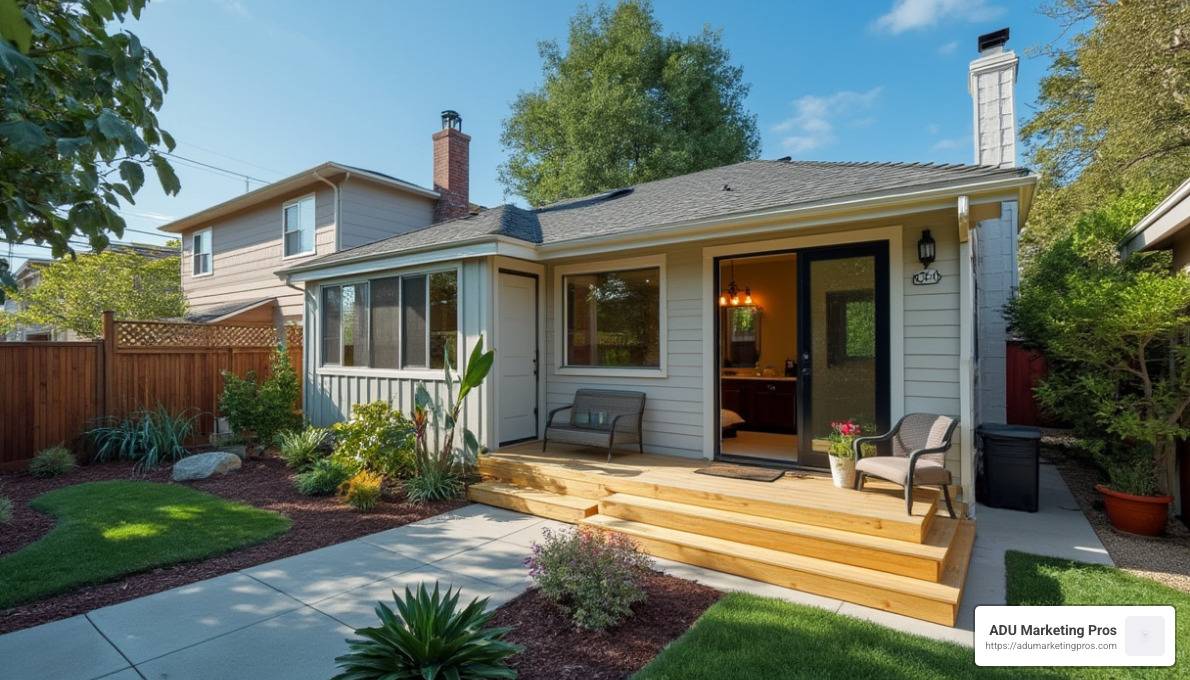Fannie Mae ADU rental income is an essential topic for homeowners and investors who are navigating the complex landscape of property and rental management. You might wonder how to make the most of your accessory dwelling unit (ADU) when it comes to generating income and contributing to affordable housing solutions. Here’s a quick overview:
- What are ADUs? Accessory Dwelling Units are additional residential structures located on the same lot as a primary home.
- Rental Income Opportunities: ADUs provide a valuable source of rental income, helping to offset mortgage costs or generate extra revenue.
- Affordable Housing Solutions: ADUs contribute to affordable housing by maximizing the use of existing properties in densely populated areas.
ADUs have become particularly popular in places like California, where housing is in high demand. By understanding how you can leverage ADUs for rental income through Fannie Mae’s guidelines, you not only improve your property’s value but also play a role in alleviating the housing shortage.

Key terms for fannie mae adu rental income:
Understanding ADUs
Accessory Dwelling Units (ADUs) are like hidden gems in real estate. These are smaller, independent living spaces located on the same property as a primary home. Think of them as tiny homes with big potential! They can be a basement apartment, a garage conversion, or even a standalone unit in the backyard.
Multigenerational Housing
ADUs are perfect for multigenerational housing. Imagine having your parents live close by without sacrificing anyone’s privacy. They offer a cozy space for family members while keeping everyone together. This setup can be a game-changer for families who want to provide care for aging relatives or young adults who need a little more independence without leaving the nest.
Environmental Footprint
Building an ADU is also an eco-friendly choice. Why? Because they make use of existing land and infrastructure, reducing the need to develop new areas. They often require fewer materials to build and maintain, which helps in minimizing the environmental footprint. Plus, their smaller size means less energy consumption for heating and cooling, making them a greener option for sustainable living.
In places like Los Angeles, where space is at a premium, ADUs offer a smart solution to housing challenges. They not only provide additional living space but also help in reducing the environmental impact by maximizing the use of existing urban areas.
By understanding the benefits of ADUs, from multigenerational living to environmental sustainability, homeowners can make informed decisions that benefit both their families and the community.
Fannie Mae ADU Rental Income
Eligibility Criteria for ADUs
When considering Fannie Mae ADU rental income, understand the eligibility criteria for these units. First, the property must be a one-unit property with only one ADU allowed. This means you can’t have multiple ADUs on the same plot if you want to qualify for a conventional loan backed by Fannie Mae.
The ADU must have a separate entrance, kitchen, sleeping area, and bathroom facilities. This ensures that the unit functions independently from the main home. Local zoning laws also play a crucial role. Your ADU must comply with these laws, although some exceptions apply, especially for one-unit properties. Always consult your lender and appraiser to ensure compliance before making an offer.
Financing Options
Fannie Mae offers several financing options that can include ADUs. One popular choice is the HomeReady loan, which allows you to use rental income from an ADU to help you qualify for the loan. This can be a game-changer for potential homeowners who need that extra income to boost their qualifying income.
To use rental income, the ADU must meet certain guidelines. For instance, the rental income shouldn’t exceed 30% of your qualifying income. Additionally, one borrower must have previous landlord experience or complete a landlord education program.
Purchase Loans
If you’re looking to buy a property with an ADU, a conventional purchase loan can be a viable option. These loans often come with competitive interest rates and terms. However, as mentioned, you’ll need to ensure the ADU meets all eligibility criteria.
Refinance Loans
For those who already own a property with an ADU, refinancing can be a way to tap into increased property values or secure better loan terms.

It’s essential to get a well-supported appraisal that justifies the property’s value, especially considering the ADU.
Renovation Loans
Another option is a renovation loan, which allows you to finance the construction or improvement of an ADU. This can be particularly useful if you’re looking to convert existing spaces like basements or garages into livable units. That these loans may have different terms and interest rates compared to traditional mortgages.
In conclusion, understanding the eligibility criteria and financing options for ADUs can open up new opportunities for homeowners and investors alike. Whether you’re purchasing, refinancing, or renovating, knowing how to leverage Fannie Mae ADU rental income can make a significant difference in your financial planning.
Tax Implications of ADU Rental Income
When you earn rental income from an ADU, you’ll need to understand the tax implications. Both short-term and long-term rentals have different rules, and knowing them can save you from surprises at tax time.
Income Taxes
Rental income from an ADU is considered taxable income. This means you’ll need to report it on your tax return each year. The good news is you can also deduct certain expenses, like maintenance, repairs, and property management fees, which can help reduce your taxable income.

Short-Term Rental
If you’re renting your ADU for short periods, like on Airbnb, the tax rules can get a bit more complex. Short-term rentals may be subject to additional taxes, such as occupancy taxes, which vary by location. It’s crucial to check local laws to ensure compliance.
Short-term rental income is generally taxed as ordinary income. However, if you rent the ADU for fewer than 15 days in a year, you might not need to report that income at all. This is known as the “14-day rule,” but it only applies if the ADU is used as a personal residence for more than 14 days or 10% of the total days it’s rented.
Long-Term Rental
For long-term rentals, where tenants stay for longer than 30 days, the tax situation is more straightforward. You’ll report the rental income on your tax return and can deduct expenses related to maintaining the ADU.
Depreciation is another important factor. You can depreciate the cost of the ADU over 27.5 years, which can significantly reduce your taxable income over time. This can be a big advantage for long-term rental property owners.
Consult a Tax Professional
Given the complexities of tax codes and local regulations, it’s wise to consult a tax professional. They can provide specific advice custom to your situation and help you steer the tax landscape effectively. This is especially important if you’re considering using the ADU for both personal and rental purposes, as the rules can vary.
Understanding the tax implications of Fannie Mae ADU rental income is crucial for maximizing your investment. Whether you’re renting short-term or long-term, proper planning and professional advice can make a big difference in your financial outcomes.
Appraisal and Zoning Considerations
When dealing with ADUs, understanding appraisal and zoning considerations is crucial. These factors significantly impact the property’s valuation and its compliance with local laws. Let’s break down what you need to know about each aspect.
Appraisal Review
Appraising a property with an ADU requires a keen eye for detail. The appraisal must account for the ADU separately from the main dwelling. This means the gross living area of the ADU is not included with the primary home’s living area. Instead, it’s reported and adjusted separately when comparing to similar properties with ADUs.
Also, the appraisal should confirm whether the ADU conforms to local zoning laws. Some ADUs might be “grandfathered” in, meaning they were built before current zoning rules and are classified as legal nonconforming. In such cases, the appraisal must verify this status.
Zoning Requirements
Zoning laws define where ADUs are allowed and what characteristics they must have. For instance, an ADU must be on the same parcel as the primary dwelling and comply with local zoning and land use regulations.
If the zoning doesn’t permit ADUs, the property might still be eligible if certain conditions are met. For instance, if the ADU’s existence won’t jeopardize future property insurance claims or if the illegal use conforms to the neighborhood and market. However, the appraisal must clearly state that the improvements don’t comply with zoning and provide analysis of at least two comparable sales with similar non-compliant use.
Comparable Sales
Finding comparable sales is essential for accurately appraising a property with an ADU. The appraiser should look for properties with similar ADU characteristics in the same market area. This includes examining sales of properties with legal nonconforming ADUs or those that are typical for the neighborhood despite zoning issues.
These comparable sales help establish a fair market value, ensuring the property’s appraisal reflects its true worth, even with zoning challenges.
Understanding these factors ensures that the ADU is properly valued and compliant, setting a solid foundation for any financing or sale. This knowledge is invaluable for maximizing the potential of Fannie Mae ADU rental income.
Frequently Asked Questions about ADU Rental Income
Does Fannie Mae allow ADU rental income?
Yes, Fannie Mae allows rental income from Accessory Dwelling Units (ADUs) to be considered under certain conditions. If you’re looking to use this income to qualify for a loan, the HomeReady loan program might be your best bet. This program is designed to make homeownership more accessible and allows rental income from an ADU to be included when calculating qualifying income.
To qualify, you’ll need to provide documentation, such as a lease agreement and a rental income analysis from an appraiser. That the rental income you can use might be capped at a certain percentage of your total income. This ensures that your financial stability doesn’t rely too heavily on rental income alone.
How is ADU rental income taxed?
Rental income from an ADU is subject to income taxes just like any other rental income. It’s important to differentiate between short-term and long-term rentals, as the tax implications can vary.
For long-term rentals, you’ll report the income on your tax return and may be able to deduct certain expenses, such as maintenance costs, property taxes, and mortgage interest, which can help reduce your taxable income.
Short-term rentals, like those listed on platforms such as Airbnb, might be subject to additional local taxes or regulations. Always consult a tax professional to understand your specific tax obligations and potential deductions.
What is a 1007 rental income?
Form 1007, also known as the Single-Family Comparable Rent Schedule, is a document used to estimate market rent for a property with an ADU. This form is essential when you’re looking to include rental income in your loan application.
The appraiser will use Form 1007 to analyze the rental market and determine a fair rental value for your ADU. This involves comparing your property to similar rentals in the area to ensure the estimated rent is accurate and reflective of the current market conditions.
Understanding these aspects of Fannie Mae ADU rental income is crucial for anyone looking to leverage their ADU for financial benefits. Whether it’s qualifying for a loan or managing your tax obligations, having the right information can make all the difference.
Conclusion
ADU Marketing Pros is your go-to partner for navigating the complex landscape of the ADU sector. We specialize in delivering digital marketing solutions custom specifically for ADU construction and architecture firms. Our expertise ensures that your business not only stands out but also thrives in a competitive market.
In the changing ADU sector, understanding the nuances of Fannie Mae ADU rental income is just the beginning. With the right marketing strategy, you can turn these insights into actionable growth opportunities. Our strategic approach, which includes targeted SEO, PPC, and social media strategies, helps you attract high-quality leads and grow your revenue.
By focusing on expertise over price, we enable your firm to become the obvious choice for clients who value quality and craftsmanship. Our data-driven insights and continuous market research ensure that your marketing campaigns are always aligned with the latest trends and consumer behaviors.
Ready to lift your ADU business? Let us help you dominate the market with our specialized marketing solutions. Explore our services and see how we can drive measurable growth for your firm.





